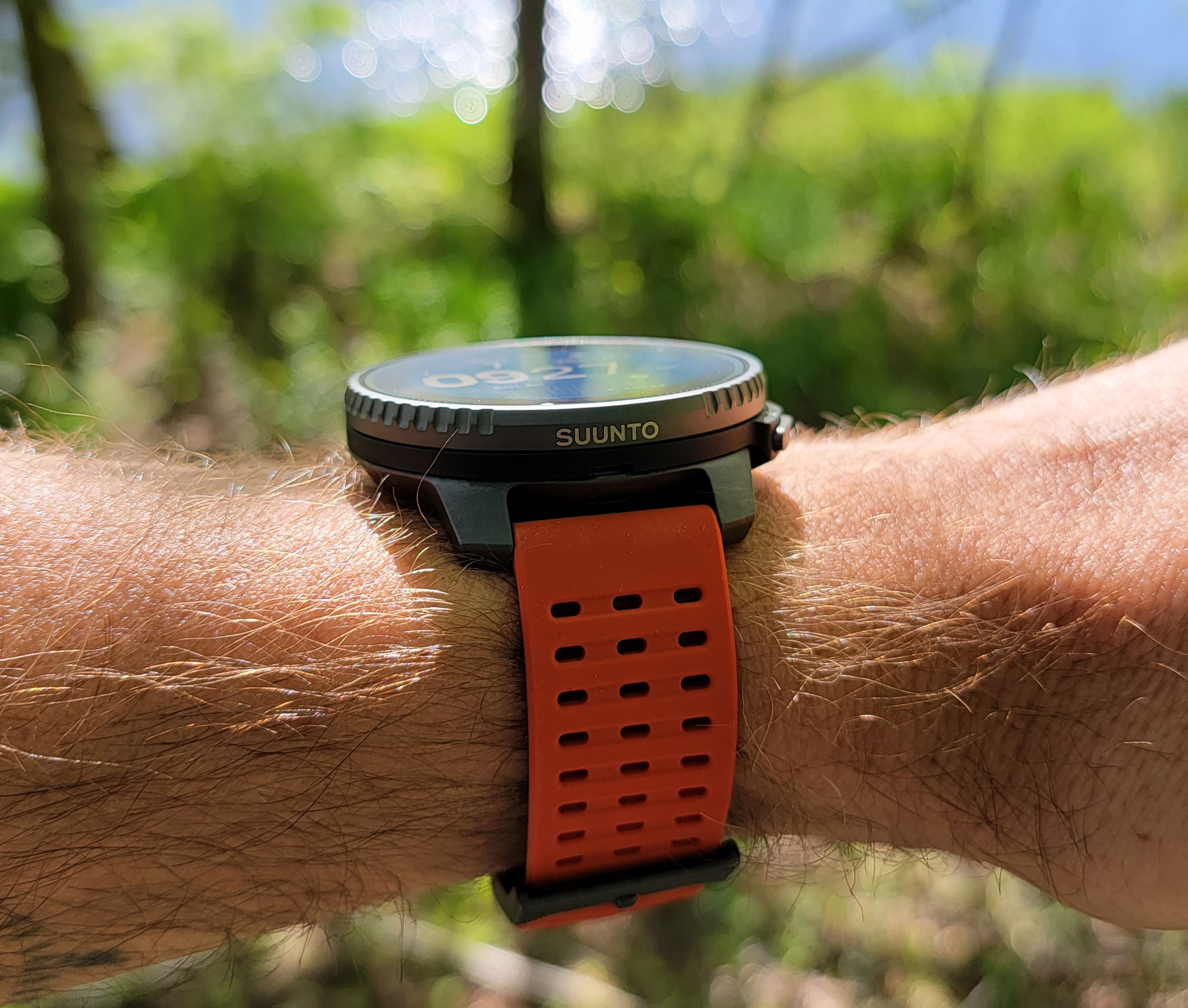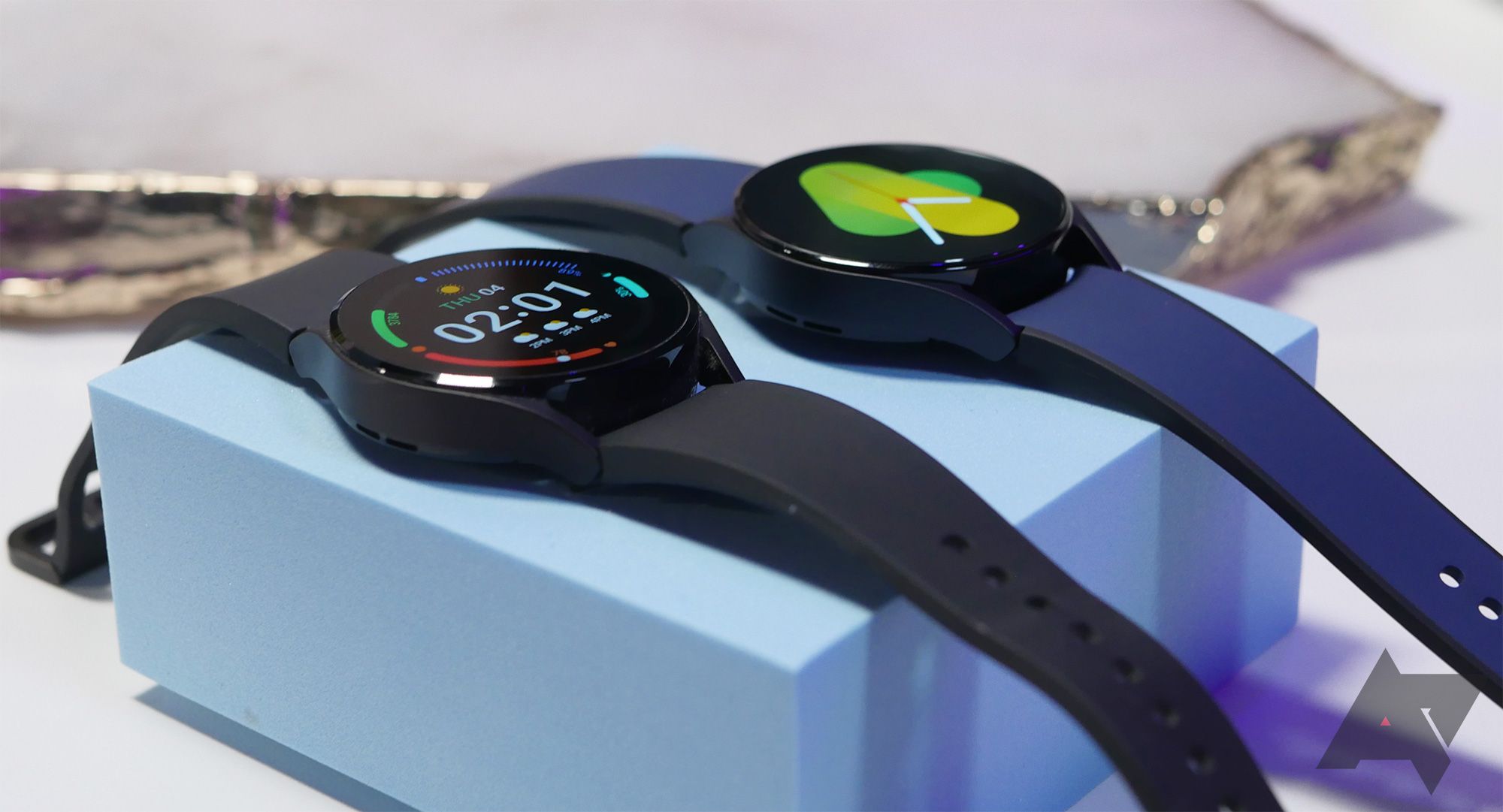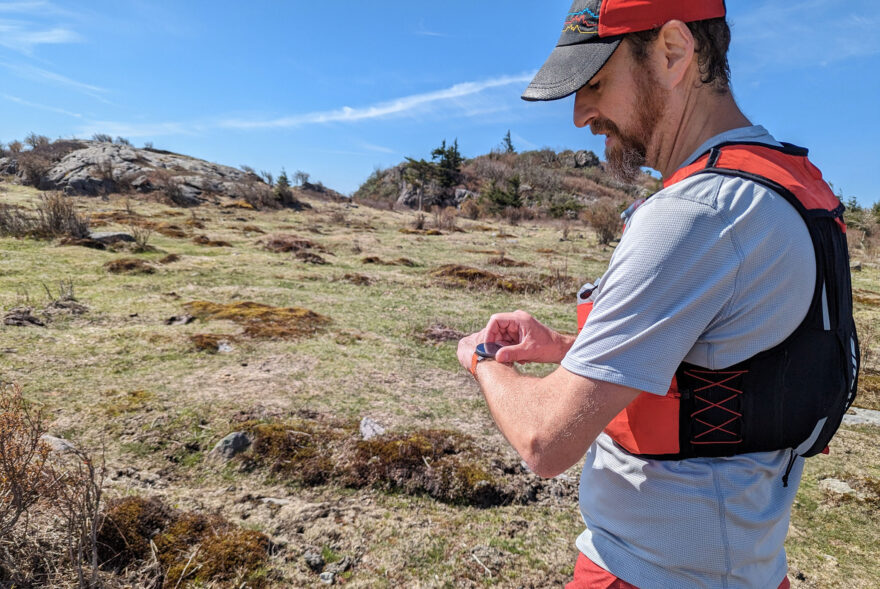
Ryan Tipps navigates using a Suunto Vertical during an ultramarathon in Virginia. (Image by Bay Roan Creative)
The sport watch brand’s latest wearables have been widely praised and provide reasons to be optimistic about the future.
Over the past year, sport watch manufacturer Suunto has undergone a tremendous revitalization — both from a product standpoint and through how it engages with its user base.
The turnaround became most notable with the release of the battery juggernaut Vertical in May 2023 and continued with the AMOLED-display Race later that year. Just weeks ago, the Race S came out, which not only packages everything the Race has to offer in a lighter and more affordable device, it also ushered in major steps in terms of heart-rate tracking, climb guidance and customization.
All three of these devices have received widespread acclaim from reviewers of tech and sports wearables, with the Race S being particularly noteworthy.
It seems like a logical leap to tie Suunto’s recent successes to its sale to the Chinese company Liesheng in 2022, but product leaders at Finland-based Suunto said that the shift that led to the Vertical’s debut began long before Liesheng’s involvement.
What Liesheng has offered, which is not insignificant, is supply chain access and increased financial and development resources.

The Suunto Race S is targeted toward people who have smaller wrists or simply want a lighter-weight watch. (Image courtesy of Suunto)
Still, the journey to this point has been rocky. Throughout much of the 2010s, Suunto had a tight grip on the trail running community. Its watches, particularly going back to the Ambit3 Peak days, boasted stout build quality and fantastic accuracy. In that era, Suunto was one of the major brands backing elite mountain athletes such as Kilian Jornet and Emelie Forsberg.
In 2018, the company began phasing out its much-loved Movescount web and app training platform and replaced it with the Suunto App, which was relatively lackluster at launch. Then COVID-19 happened, and Suunto failed to take advantage of a world that was excited to reconnect with nature and go off-grid as a way to social distance.
Garmin steered heavily into lifestyle features in its watches during that time, and newcomer Coros began to siphon off the trail runners that were at the core of Suunto’s community.
“In a lot of industries, COVID was a negative, but in the outdoor industry and specifically in wearables, COVID was a boost to the business,” said Dan Suher, Suunto’s sales director for the Americas and a former employee at Coros. ”If you look at who was the most direct competitor at the time, you saw Coros targeting a lot of trail running, relying on battery life as the main feature set. Coros was and is the most direct competitor for Suunto.”
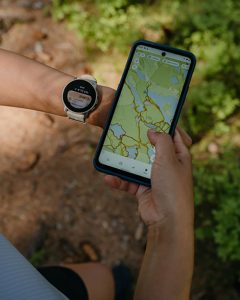
Image courtesy of Suunto
For nearly 90 minutes, Suher, whose background is as a high school and collegiate runner and in sales for brands like Saucony, spoke with ActionHub about how Suunto brought itself back from the brink, the direction in which the company is headed, and why the latest product release adds so much value.
These latest watches are helping Suunto “hit one of our targets for this year, which is first and foremost trail running,” Suher said. “That’s backed by a major investment in the UTMB World Series and in athletes like Courtney DeWalter and now Zach Miller and Abby Hall. We are absolutely digging in both on the product and the marketing to gain that segment back.”
(Editor’s note: This Q&A has been edited for clarity and brevity.)
ActionHub: Back when Liesheng purchased Suunto, a lot of people asked whether that would help make Suunto relevant again. How has that factored into the trajectory over the past two years?
Suher: There’s always challenges when you’re dealing with international business, there’s lots of cultures in play. We’ve got the U.S. culture; we’ve got Finnish Nordic culture, which is very rigid and process-oriented; and then there’s Chinese culture. But we’re still manufacturing the majority of our products in Finland, and the majority of the research and development is in Finland.
But we also have added benefits on the supply chain side from having Liesheng ownership.
We’ve even extended our product line to include headphones because Liesheng is one of the largest OEM manufacturers of Bluetooth headsets. So, I joke, if I’m sitting in the C-suite, are headphones the next big bowling pin I’m knocking over. Maybe not but it’s very much a complimentary product, and it widens the Suunto story.”
ActionHub: Can you talk more about what kind of things were happening around COVID that impacted Suunto?
Suher: At that time, you saw the Suunto 3 fitness tracker, and the Suunto 7, you know, the smartwatch that wasn’t quite smart enough for the smartwatch people and wasn’t sporty enough for the traditional sport watch people.
And from there, we began to dig in on who our target demographic is, and I believe we’ve identified that. We’re now making product really specifically for them. When we look at the sports wearable market, it’s anywhere from an $8 billion to $10 billion segment globally.
And when we look at the smartwatch market, it’s about 10 times that.
For years, Suunto was synonymous with trail running, especially if you go back to the Ambit series, like the Ambit3. I can recall athletes that we brought in at Coros who still spoke about that watch. So, the thought was, if we could repackage what people loved about the Ambit3, but have more modern battery life and all that, that’s what they were looking for.
And now we’re back there and then some.
By and large, the important stuff for people is the performance piece. And we’re creating a lot of value. Even against my previous brand, which touted itself as the battery leader, apples to apples comparing dual frequency and all-systems tracking, Suunto is crushing them in the battery department.

Image courtesy of Suunto
ActionHub: Looking back a year ago to when the Vertical first launched, that was essentially the first of this new generation of product. So how does the Race S fit in?
Suher: We identified very quickly that we needed a smaller watch, but one that still had the same feature set and was as powerful as the Race. The Race S has a little less battery life because it is a smaller, thinner package, and we just can’t fit the same battery in it, but it is a really powerful watch in a smaller form factor.
The Race S definitely goes toward a smaller-wristed audience, often female. But there are also simply people who want a lighter weight watch. There’s been this trend, especially with mapping, to go to these bigger watches that you get the most out of the maps. But that does ignore the people who don’t want or can’t really take advantage of a watch that’s too big for them. It looks funny and, not to mention, there’s also optical heart rate benefits in a smaller watch.
ActionHub: I was certainly going to ask you about the HR stuff, because generally speaking, that seems to be the biggest complaint about Suunto devices.
Suher: It’s being addressed. The Race S has a new heart rate sensor, with a couple of added photodiodes on it.
Suunto continues to get feedback from all of our wear testers, and that’s something they were really making sure about, that this new sensor was better.
And the optical heart rate benefits in a smaller watch are because it has a better fit to the wrist, to be able to get a better reading. Inherently a smaller watch, all other things created equal, is going to be better with heart rate readings.
ActionHub: Can we expect more from HR sensors in watches moving forward?
Suher: They will eventually get new sourcing and new sensors in future iterations, Whether that’s ’25 or ’26. I haven’t seen a 2025 road map yet.
But I think, in general, optical heart rate is a very imperfect technology. Some sensors are better than others without a doubt, but there’s always going to be some level of complication: darker skin tones, tattoos. I personally have never had major issues, but I’m fair skinned.
What I’ve always said, and this is across any brand, if you are somebody who trains specifically to heart rate, get a chest strap or arm strap or whatever it might be, get something that’s not optically based.
If you’re looking for a trend, for me consistency is the bigger thing. Let’s say it’s measuring five beats higher than my actual heart rate or 10 beats higher. As long as it’s always 10 beats higher and it’s consistent, then great. That’s all I want to see. I want to know: Was I working harder today than I was yesterday?
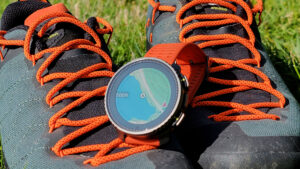
The Suunto Vertical is the first watch built on Suunto’s UI that has on-board maps. (Image by Ryan Tipps)
ActionHub: How do you go about bringing more partners into the mix and working with Suunto?
Suher: There’s more and more performance-focused wearable technology out there. And right now, our goal as a brand is to be able to integrate with as many of those as possible, because they’re just so specific.
But it does get to where, at some point, is somebody going to have a Stryd on their foot, a Suunto watch on their wrist, a sweat monitor on one arm, a glucose monitor on the other …
ActionHub: Admittedly, another complaint I often hear is that you can’t pair more than one type of sensor at a time with Suunto watches.
Suher: Any company has to take a look at what are their resources and what is going to either be the most beneficial to the most people or be the most beneficial from a brand. Some things you do are more brand focused, while some things you do are more product or consumer focused — and it’s a balance of the two.
If something’s going to be beneficial to a couple percentage of users, and doesn’t really have a halo effect on the brand side, that’s probably lower on the totem pole. I don’t make those decisions as far as the priorities are, but I give input on occasion for features that I would like to see.
ActionHub: What does the launch of the Race S mean for the 9 Peak Pro, which was technically the first watch launched with Suunto’s modern UI, even if it doesn’t have all the bells and whistles of the Vertical and Race lineup?
Suher: The 9PP right now retails for $349, which is the same price point that the Race S is sliding in at. So it’ll soon get a price adjustment. We are still figuring out exactly how aggressive that price adjustment will be for this market.
We have to look at what our building material costs are on something like that. And we have to remember that once upon a time, that was a $600 watch. So we’re getting closer and closer to it no longer being a profitable franchise. It’s still in the line because it’s on essentially the same operating system as the Vertical and Race, but it is the only watch in our current lineup that’s still single band. So that’s something to keep in mind too.
Race S is more or less designed to replace it and modernize it. But with the 9 Peak Pro being a MIP display, it may still have a place in the line through the end of the year or even longer. There’s just a matter of whether it can be engineered now with some new supply chain options that we have and can it be sold profitably at a price point that’s in the mid-$200s. If so, then maybe it has a new place to live for at least a little while longer, so that there is another MIP option in the lineup besides just Vertical.
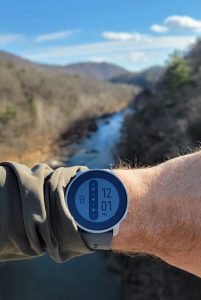
Image by Ryan Tipps
ActionHub: What do you see as a couple of the larger trends in the sport watch market, especially with your background now at two different companies?
Suher: The first is that dual frequency is effectively now standard fare. And ultimately, the two or three major chip manufacturers that are out there will continue to refine what they have and how efficient the dual frequency is. We have a really good advantage that the chip that we use is a Sony chip that is very efficient in dual frequency.
Another thing we’re already seeing, obviously, is AMOLED displays coming into play in a bigger way. Only Coros has not gone there yet, but I’m sure they will. With that kind of display, it’s a matter of how efficient that can be. The draw against AMOLED, specifically with the Apple Watch going back several years, was how awful the battery life was.
But we have now been able to make an AMOLED device that on dual frequency can go 45-plus hours of GPS tracking. I mean, there wasn’t a watch on the market with a MIP display four years ago that had that kind of battery life, even without dual frequency. Things today are becoming more and more efficient.
If I’m taking the Suunto hat off and just thinking big picture, I also wonder about all these other wearable tech, whether it’s Whoop or the Oura ring or others. When you’re seeing sleep make its way into the sport watches, that’s significant. It’ll be interesting to see what other sensors or capabilities can be integrated in sports watches, and not just in terms of an API connection.
ActionHub: I was trying to think about what’s really left to add to a sport watch that isn’t already done in some capacity.
Suher: I guess you have to decide if the goal is to be a health and fitness product, or is it to become a medical device of some kind? It’s a story of efficiency. It’s possible we’re going to have more storage, so that you can have bigger, more detailed maps and can store more routes, more waypoints.
Those are probably the most natural progression. But who knows? Maybe Sony comes up with a tri band chip?
ActionHub: We’ve talked about AMOLED being one of the big trends, and major reviewers like DC Rainmaker and Desfit love them compared with MIP displays. So, moving forward, are MIP displays dead?
Suher: I don’t think so because when we see the forums and things like that, there are still fans of MIP. Granted AMOLED is way better in bright light than it used to be, but there’s still more battery depreciation with AMOLED and some level of risk of screen burn if not handled correctly.
And MIP is still in our performance-focused category, so I don’t know that MIP will ever completely go away. I do think it’ll move to the minority, however. We like where we have it living in the Vertical, since that’s our adventure watch. It’s our longer-battery-range watch. I think it makes sense there.
I like even look at a company like Garmin, and while they’ve changed a lot of their lineup to be AMOLED, their Fenix is still a MIP display.
ActionHub: Not too long ago, I saw you respond to somebody on Facebook, when they talked about “Suunto’s quarterly update.” And you said, tongue-in-cheek, that you didn’t know that that timeline exists, at least not officially. In today’s modern sport watch market, what should people expect in terms of a duration for a new watch to continue to get updates down the road?
Suher: On Facebook, and this goes back to my time at Coros, where I was very involved in the brand pages and things like that, I try to be helpful but have some fun with it too.
I don’t know that there is an answer to your question, unfortunately, like how long to expect it. I think we are getting spoiled. I would think a good rule of thumb is that the product is likely going to continue to be supported when the next version comes out.
Once two versions later come out, it’s probably fair that things would trail off. That’s not to say that it won’t still get support, right? But it’s probably fair to say that I don’t know if I’m going to get new features. And I will give credit where it’s due to my former employer, because I think they were really the first to give frequent updates, yet they kind of did it out of necessity, because oftentimes they launched a product before it was 100 percent ready.
When the Apex first came out in 2018, there was this promise that it will have breadcrumb mapping on it. It was a pain because people were like, when’s it coming, when’s it coming, when’s it coming? First off, never promise that something’s coming. That’s a lesson learned. But, if you look at that watch from when it was launched to what it offered by the time it stopped receiving updates, it was a totally different watch and you didn’t pay a single dollar for that added benefit.
So what I always tell people is, buy something because it meets your needs today and then be pleasantly surprised with each incremental update that you receive and new features that you receive.
When you buy an older watch, you have to have some type of ownership of the fact that you’re buying a product that has been in the market for three or four years and that it may not change. And in what other world do we buy something where the product gets better? I think there’s a little bit of management of expectations that has to go into the process.
ActionHub: But you’re talking features, not necessarily warranties or repairs, right?
Suher: We have a repair center in Helsinki and a contract repair center in Texas, outside of Dallas. And so you can have an issue with a product, and as long as the components are still available, we’ll replace them — if it’s out of warranty for a fee or at no charge if it’s in warranty.
And so that just becomes an issue of supply chain. To put it in perspective, the Suunto 7 came out in 2018, but we are just now getting to the point where we don’t have some components for repairs. So that’s been six years.
Most people hold on to their watches anywhere from two to five years, depending on what their cadence is and their need for new technology.
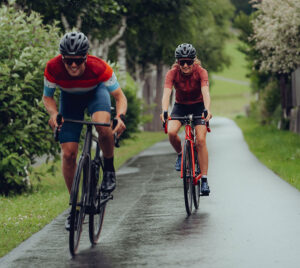
Image courtesy of Suunto
ActionHub: What is your philosophy with engagement on social media? Because admittedly, prior to you joining the company last year, I don’t feel like Suunto engaged much outside of the officials forums.
Suher: I don’t really identify myself necessarily as a Suunto employee all the time, but you are out there. First off, the Suunto fans group is run independently, and nobody from the brand is officially a moderator. I think there’s one or two folks in the company that pop up there.
At Coros, that kind of engagement was big for us, including the CEO. And it really helped offload a workload for the support team. It also helped me keep my finger on the pulse of what people were wanting, what were people experiencing and what’s the feedback about the brand — the good, bad and ugly.
Having the CEO and other senior leaders be involved in those forums or on social media, I think is helpful in in both directions. I think it creates a level of loyalty because I can almost guarantee that the CEO of Garmin not responding to stuff on Facebook.
It’s something that I’m preaching internally at Suunto. I’m trying to get other members of the team involved, but certain cultures are very different. With the Nordics and Europe as a whole, it’s kind of like: I work at work and I don’t when I’m not, and it’s the 40-hour work week. I respect that. But that’s just not our culture here in the U.S. I have urged others in the company, to senior leaders and to executive team members, take 30 minutes out of your week, go in and see if there’s somebody that you can respond to and identify yourself.
My goal is, and this has always been the case, I want to match the needs of the consumer for the lowest possible price. So if somebody wants Spotify and that’s a must have, then there’s only one brand, well not counting Apple, but there’s only one brand in the sports world that’s going to be able to offer that.
And that’s fine because I’d rather that than have somebody be disappointed, right?
ActionHub: Since Suunto was bought by Liesheng, we’ve seen Suunto launching at least a few accessories. How does the accessory market fit into the company and its broader growth strategy?
Suher: One of the big things for us is we have to not think about headphones as an accessory. We want to view the headphones as a complementary product line, but a product line within itself.
When we look at accessories, it’s things like heart rate straps, it’s things like replacement bands and those are very important, too, because they are they’re expanding the lifetime value of a customer. It’s funny: I had my former companies starting to do more colors and things that I really preached when I was there from a sales standpoint, because, you know, if I’m not buying a watch every three to five years, I still would like to have some revenue coming in from that customer with new band colors, new materials, all that kind of stuff.
What the headphones allow us to do is to broaden our reach but also potentially reach a customer that for instance, Spotify is a must have for them. So maybe they’ve bought a Garmin, but we still would like to be a part of their adventure.
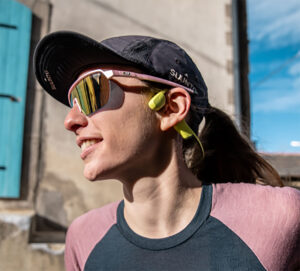
Image courtesy of Suunto
ActionHub: For me, the carbon offset was huge factor that helped set Suunto products apart from the competition. But then once some production moved to China for the original Race, that didn’t seem to be as significant part of the strategy. Can you talk about where Suunto is with that?
Suher: Sustainability and the carbon life cycle audit is still a very, very big part of the company, regardless of where the product is made.
We did ultimately do a carbon lifecycle audit on the Race, though I don’t recall if it was ready at the time of launch like it was for Vertical. But we have since published that, and we will have it for the Race S and our other new watch, the Suunto Ocean.
Really, the only difference when it comes to our watches when they’re made in Finland versus made in China is the Finland factory itself is run on renewable energy. Not so in China, but I will say it’s a company-owned facility. So in terms of some of the other conditions, it is at a higher standard than if this was a third party.
For our devices, what we do is a lifecycle audit that is done independently. Regardless of the factory, we then publish that on our website. We also have our sustainability report that gets published once a year. We’re probably due for our next report — I think sometime in Q3, though maybe later.
And then the last thing is we do is a carbon offset. Typically, that offset is done through the planting of trees, but really, it’s relative to the type of product. So if it’s an adventure or a trail running product like Race or Vertical, we’re planting trees in forests and trails and things like that. With the Suunto Ocean, because that’s a dive product, we’re planting mangrove trees. That’s something that nourishes a water-based ecosystem and helps protect shorelines.
So it’s very purposeful. And we’re not buying carbon offsets. We’re not just throwing money around. It is purposeful and it goes to the full story.
Ryan Tipps is Managing Editor for ActionHub. He lives along the Blue Ridge Mountains, is an avid hiker, backpacker and trail runner and has been a part of the wilderness search and rescue community since 2005.

